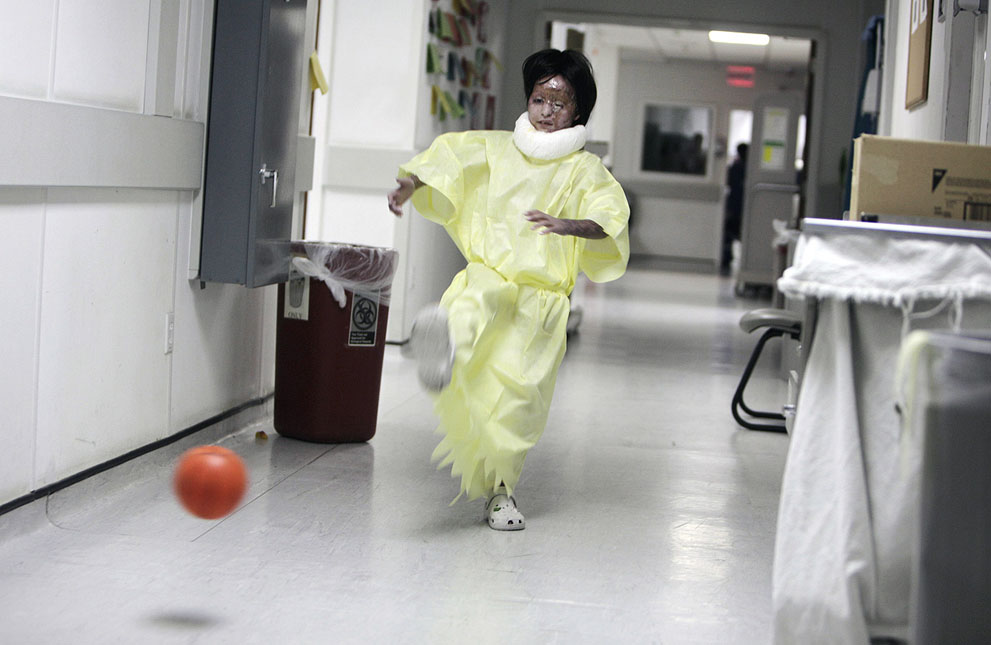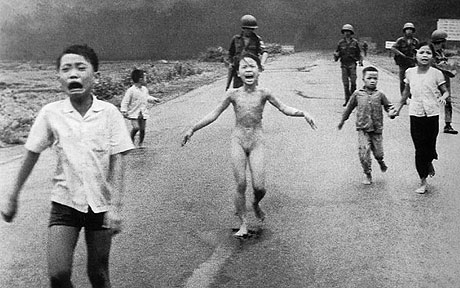The slide shows currently are full of human interest shots from city streets, small towns, tourist havens, summer festivals, and similar settings where people can kick back a bit and enjoy life. But for one detail, this photo could easily be included in the mix.
A girl kicks a ball down the corridor of a hospital, reminding us that you don’t have to be at the beach to have a good time. The red ball is clearly out of place in the grey and white functionalist decor, and the pastel gown now seems a bit festive, adding to the contrast between her free spirit and the institutional setting. What’s not to like?
The caption read, “8-year-old Razia plays ball at the U.S. military hospital in Bagram Air Base, north of Kabul, on June 11, 2009. Razia was evacuated to the hospital in May after she was severely burned when a white phosphorus round hit her home in the Tagab Valley, killing two of her sisters during fighting between French troops and Taliban militants.”
And so we get to her face. That, and not the 2009 date is the reason this photo isn’t a human interest story. But why bring it up now? 2009 was, well, a long time ago, and isn’t the US pulling out of Afghanistan, or something like that?
The basic reason I’m writing about the photograph now is that none of us are likely to have seen it earlier. Fortunately, Alan Taylor at In Focus apparently thought that August shouldn’t be devoted entirely to forgetting about the rest of the world. This image is part of his current retrospective on Afghanistan’s Children of War. Some viewers may find it inappropriate–say, because it might invoke pity, or exploit the child or childhood, or suggest that the US cares for the war’s victims as much as it might harm them. Those reactions may be worth discussing, but I want to go back a step and ask why the image was not seen previously or regularly and widely in the first place.
More to the point, why has it not played a part in public discussion of the war in Afghanistan, despite its similarities to another photo that continues to be a flash point for debate about the Vietnam War?
You will recognize this iconic image of Kim Phuc and other children running from a napalm attack. Obviously, the photos are not identical. The girl in one photo is naked, while in the other she is fully clothed. One is alone in a safe place, while one is part of a traumatic event whose shock waves are still reverberating through others in her family. Combat soldiers are bringing up the rear in Vietnam, while we see what appear to be medical personal in Afghanistan. Oh, and one is burned on her face (at the very least), while the other is burned on her back and arm. And one was burned in June and the other in May. . . . Very different images, right?
Well, not exactly. Napalm then, phosphorus now. The girls were about the same age at the time. Both had siblings killed in the attack that wounded them. The attack in each case was by US proxies. Both attacks were hardly unique, but rather examples of what had become all too common occurrences. And the wars. . . . .
John Lucaites and I have written a fair amount about this iconic image (see chapter six of No Caption Needed), so let me be very clear that I don’t think one can explain exactly why some photos acquire iconic status and others don’t. John and I identify many possible factors, but the outcomes can depend on many accidents of history. That said, it still is fair to raise the question of why a burned girl was major news then and not now. One very bad answer is that the public is experiencing “compassion fatigue”: as David Campbell has argued, this is a myth of media influence rather than a real problem of public responsiveness.
I would argue that the first photo both hampers emotional response while also lacking some of the other important features of iconic composition. To put the matter very simply, her playfulness complicates one’s reaction to her injury, while cues for public significance are missing due to the dominance of the hospital setting. By contrast, the soldiers, family, and road are important elements for framing the naked girl’s suffering, which is being voiced. Thus, the difference in uptake may be due to important differences in the photos themselves.
But still. I have to think that something else is involved. Something like compassion fatigue, perhaps, although neither merely emotional nor a myth. Too many people have simply gotten used to not paying attention, to accepting what are essentially colonial wars as business as usual, to not caring in the first place what happens over there.
The military learned a lot from Vietnam. The American public, not so much.
Photographs by Rafiq Maqbool/Associated Press and Nick Ut/Associated Press.


There’s definitely A LOT of the latter as to why seemingly iconic photos no longer carry their weight with the public. A WHOLE LOT…
But it’s not just ignorance and indifference, there’s also a helluva lot of unemployed, underemployed, newly homeless, and in constant fear of being homeless people out there who are just plain hurting in their own lives. Compassion fatigue just begins to address the situation.
On a more formalistic note, the hospital photo doesn’t cut it visually to the degree of the classic Viet Nam photo- even though her wounds may be more severe in the former. The Nam photo lays it all out from first glance, further study elicits details that enhance and further the narrative. Indelicate as it may sound, you even have elements of the classical nude form thrown in the mix. The hospital photo is more surreal, but harder to read. The face is mask like, the hospital gown ghostlike and the surrounding pictorial elements make for neither a strong composition, nor an easy narrative. These photos have a very strong social commonality, visually they are (literally) worlds apart.